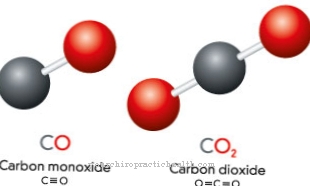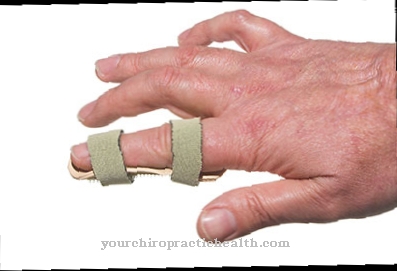A Granuloma annulare is a granulomatous skin disease associated with ring-shaped papule formation and which particularly affects children, adolescents and women. The skin disease is harmless and in many cases disappears again without therapy.
What is granuloma annulare?

© Andrey Popov - stock.adobe.com
Granuloma annulare are benign, nodular papules (skin nodules or vesicles) that occur primarily on the hands and feet and which primarily affect children and adolescents.
The ring formation is characteristic of an annular granuloma, which manifests itself at the beginning with white or skin-colored papules, which later recede centrally while spreading to the periphery, so that a ring is formed. Here the skin of the ring is slightly raised and consists of several papules and knots lined up next to one another.
Granuloma annulare can occur in single or multiple herds (especially in younger children). In addition, in the case of granuloma annulare, a general distinction is made between the disseminated form, in which aggregated nodules and papules are distributed over the entire body, and the subcutaneous nodal form, which is mainly associated with nodes in the subcutis (especially on the head, buttocks and legs) .
causes
The causes for the manifestation of a granuloma annulare have not yet been clarified. In previous studies, the disease was often associated with latent diabetes mellitus, but more recent research has not been able to demonstrate a statistically significant correlation.
Current studies indicate a connection with a disturbed lipid metabolism, although it is unclear whether the metabolic disorder is the consequence or the trigger of a granuloma annulare.
Cell-mediated or humoral overreactions of the immune system to as yet unknown agents and in individual cases also trauma, excessive sun exposure and insect bites are discussed as possible triggering factors. The disseminated form of granuloma annulare is also associated with an underlying HIV infection.
Symptoms, ailments & signs
Granuloma annulare is a harmless disease that is characterized by an accumulation of small lumps on certain areas of the skin. The nodules do not cause itching or pain. Granuloma annulare in particular can affect female children and adolescents. The ring-shaped expansion of the nodules is typical.
Within a few weeks, ever larger rings of papules form, while the older nodes begin to regress in the middle of the ring. However, the annular (ring-shaped) arranged nodules remain for some time (months or even years) without treatment. But they do not cause any discomfort. The backs of the hands and feet as well as the extensor sides of toes, fingers, feet and hands are particularly affected.
Ring-shaped groups of nodules are also occasionally observed on the forearms and lower legs. The papules also occur less frequently on the elbows, the trunk, the buttocks or the face. There are patients with single rings. However, other sufferers also have multiple rings. Furthermore, some special forms of granuloma annulare are known.
In adults, for example, scattered nodules appear on different parts of the body such as the extremities and the entire upper body. In some cases, a connection between HIV infection and this disseminated special form of granuloma annulare could be established. A subcutaneous nodule shape is sometimes found on the head, buttocks and legs, in which the nodules are located under the unchanged skin.
Diagnosis & course
A granuloma annulare can usually be diagnosed on the basis of the clinical symptoms, in particular the characteristic ring formation caused by the papules typical of the skin disease. In unclear or asymptomatic cases, the diagnosis is confirmed by means of a biopsy with a subsequent histological examination.
Thus, under the microscope, histopathologically, a scarcely changed epidermis can be seen with necrobiotic areas, which in the corium (also dermis, dermis) have differently degenerated collagen fibers. Mucopolysaccharides, a greatly increased concentration of glycogen, epithelial cell granulomas and lymphocyte infiltrates can also be found in the dermis.
In the differential diagnosis, an annular granuloma should be differentiated from rheumatic nodules, necrobiosis lipoidica and an annular sarcoid. The course and prognosis are generally good for granuloma annulare, and spontaneous regression can be observed in more than half of those affected within 2 years.
Complications
In most cases the granuloma annulare does not lead to particular complications or discomfort. Even without treatment, the symptoms usually go away on their own and the disease heals on its own. Those affected suffer from papules that can be distributed all over the body. The skin in the affected areas is also red in color and can itch.
In most cases, the granuloma annulare occurs on the fingers, hands and feet and can lead to restrictions and discomfort in everyday life. It is not uncommon for this to cause pain when walking, which leads to restricted mobility.
If the pain also occurs in the form of resting pain at night, this pain can lead to sleep problems and thus to further psychological upsets. In general, the granuloma annulare has a negative impact on the patient's quality of life.
In most cases the granuloma annulare does not need treatment and disappears on its own. Only in severe cases are creams and ointments used to relieve the symptoms. There is usually no scarring and the life expectancy of the patient is not reduced by the disease.
When should you go to the doctor?
Consultation with a doctor is necessary as soon as skin changes appear on the hands and feet. In children and adolescents in particular, any abnormalities should be observed and presented to a doctor as soon as possible.
If you experience itching or restlessness, this must be observed. If the affected areas are scratched open, sterile wound care must be used. If this cannot be guaranteed to a sufficient extent with your own aids, you should seek the support of a doctor or a doctor's assistant.
If circular poplars, ulcers, growths or nodules form on the skin, these abnormalities should be examined and clarified. A doctor is required if the symptoms cause impairments of all kinds in everyday life. If the locomotion cannot be carried out as usual, if a one-sided physical strain sets in or if the posture is tilted, a doctor must be consulted. Permanent malfunction of the skeletal system threatens.
If the symptoms of the hands or fingers interfere with daily activities such as writing, brushing teeth or holding objects, a doctor should be consulted. If the person concerned complains of insomnia or malaise in addition to the physical symptoms, or if he behaves abnormally, it is advisable to contact a doctor.
Doctors & therapists in your area
Treatment & Therapy
Since a granuloma annulare is usually harmless, does not cause any symptoms and in many cases resolves spontaneously, it does not need to be treated from a purely medical point of view.
In particular in adult patients, in whom regression of the granuloma annulare can be observed less often without therapy, therapeutic measures are nevertheless often used for cosmetic reasons.
A therapy with glucocorticoids or steroids, which are applied with the help of ointments or creams, is a standard option. In this regard, effective film dressings (so-called occlusion therapy), direct intralesional injections of the corticosteroid preparations into the affected skin areas and freezing with liquid nitrogen (cryotherapy) have proven effective.
Although topical corticosteroids quickly cause the granuloma annulare to regress under occlusion conditions, possible side effects such as skin atrophy should be taken into account when choosing the therapy given the high rate of spontaneous regression. If the disseminated form of granuloma annulare is present, systemic therapy with dapsone or isoniazid (isonicotinic acid hydrazide) or PUVA therapy may be indicated.
As part of PUVA therapy, the affected areas of the skin are irradiated with UVA light in a special phototherapy cabin. The therapy is carried out three to four times a week for a period of several months and usually causes permanent disappearance of the granuloma annulare. In quite a few cases, minor interventions such as trial excisions or saline injections can lead to a complete regression of the granuloma annulare.
Outlook & forecast
The prognosis for granuloma annulare is very favorable. The disease is considered to be potentially harmless by doctors and scientists and, under normal conditions, does not lead to any severe impairments that weaken health. Complications or illnesses in the further course of life are also not to be expected.
Normally, the skin's irregularities recede independently within a few weeks and without external influences or the administration of medicines. Medical care is not required for most patients with this condition. The changes in the complexion of the skin can lead to irritation and emotional discomfort due to the visual flaw.
On the physical level, from a medical point of view, the disease does not trigger any concern or need for action. It is viewed as a temporary phenomenon that may need to be examined. When you visit a doctor, the focus is on excluding other skin diseases. It must be clarified that the skin changes can be assigned to the granuloma annulare and that there are no serious disorders.
If psychological problems develop as a result of the optical irregularities, a therapist should be sought to improve health. There are other issues with the sufferer that contribute to deterioration in wellbeing and should be treated. Their prognosis has to be considered individually.
prevention
Since the causes of a granuloma annulare have not yet been clarified, the skin disease cannot be prevented.
Aftercare
In the case of granuloma annulare, there are generally no options for follow-up care available to those affected. However, these are not necessary, as this disease is a relatively mild and harmless disease that in many cases disappears on its own. Medical treatment is usually only necessary if the granuloma annulare does not heal itself.
In general, those with granuloma annulare should observe a high standard of hygiene to prevent the disease from spreading. If the disease does not go away on its own, creams or ointments can also be used to relieve the symptoms. It is important to ensure that it is used regularly.
Even after the symptoms have disappeared, the creams should continue to be used for a few days in order to reduce the discomfort completely. In severe cases, however, treatment by a doctor is necessary. The disease does not have a negative impact on the life expectancy of the person affected.
If granuloma annulare occurs frequently, the cause of its occurrence must be identified in order to avoid the disease. If the person is itchy, they should not scratch the skin to prevent scarring.
You can do that yourself
In many cases the granuloma annulare does not need treatment. If it does not start with severe symptoms or complications, treatment can be omitted, whereby the symptoms often go away on their own. As a rule, the patient has various options for self-help in order to limit the symptoms of the disease.
The use of creams and ointments has a very positive effect on the symptoms of the disease and can significantly limit them. Above all, the itching can be eliminated with breastfeeding creams, which often also cool and soothe the skin. Especially with children, it should be pointed out that constant scratching only worsens the symptoms and can lead to the formation of scars. Scratching should therefore be avoided in any case.
In the case of inferiority complexes or a reduced self-esteem, discussions with other sufferers or with a psychologist often help. As a rule, talking to your own partner has a very positive effect on the disease. The granuloma annulare does not have a negative impact on the life expectancy of the patient.



.jpg)
.jpg)























